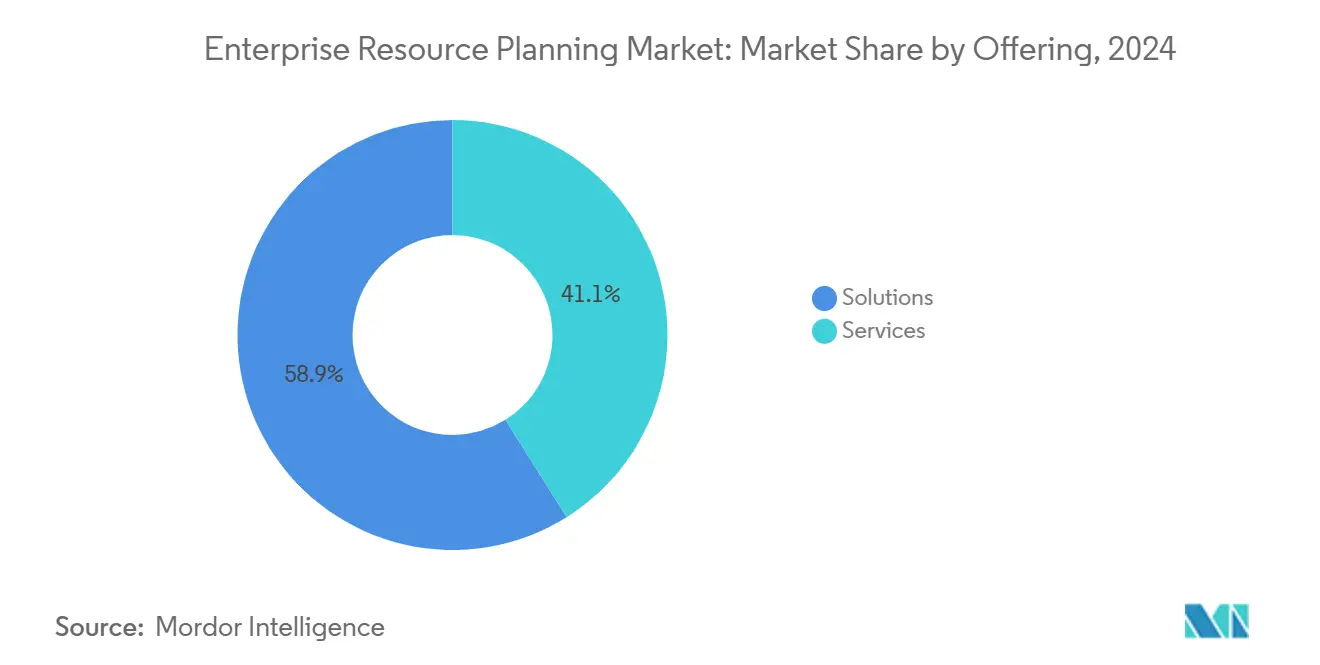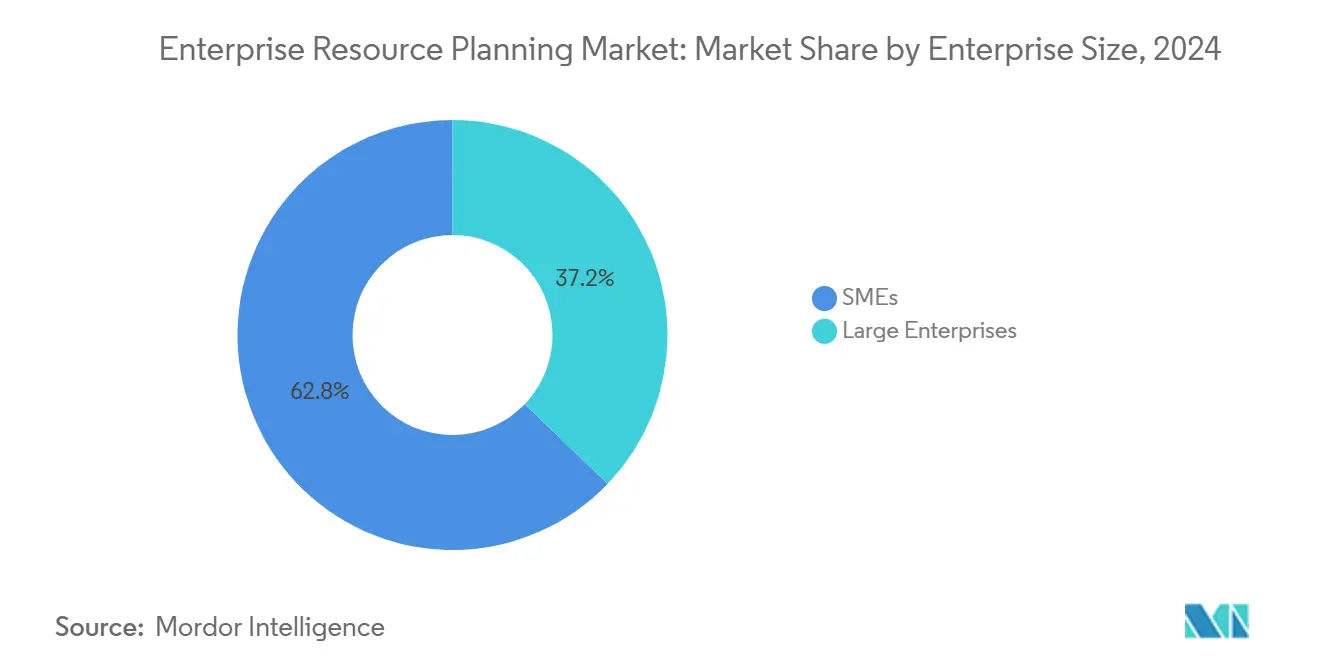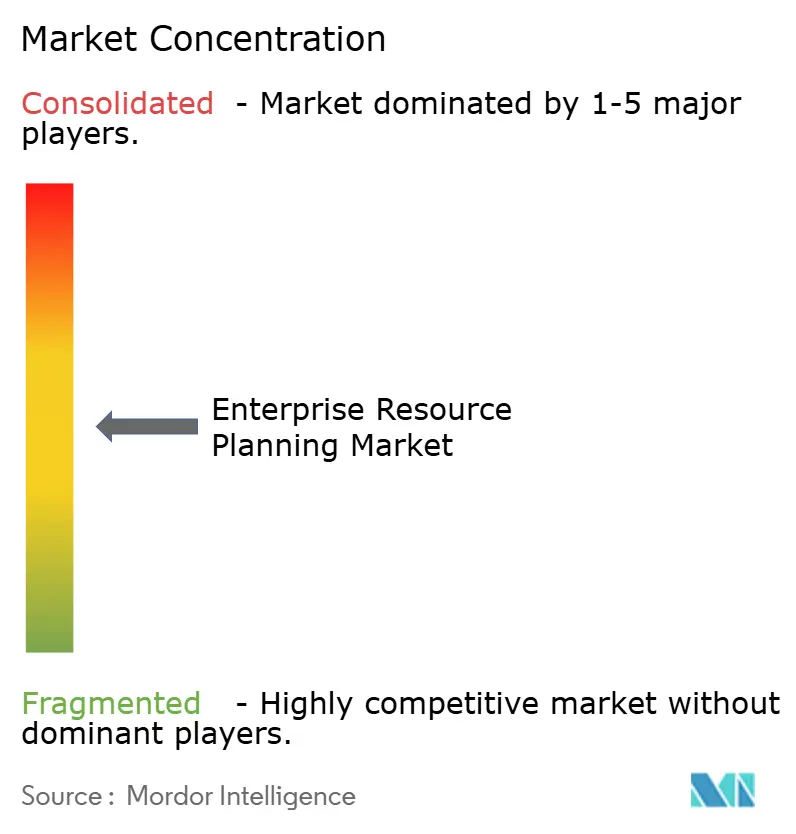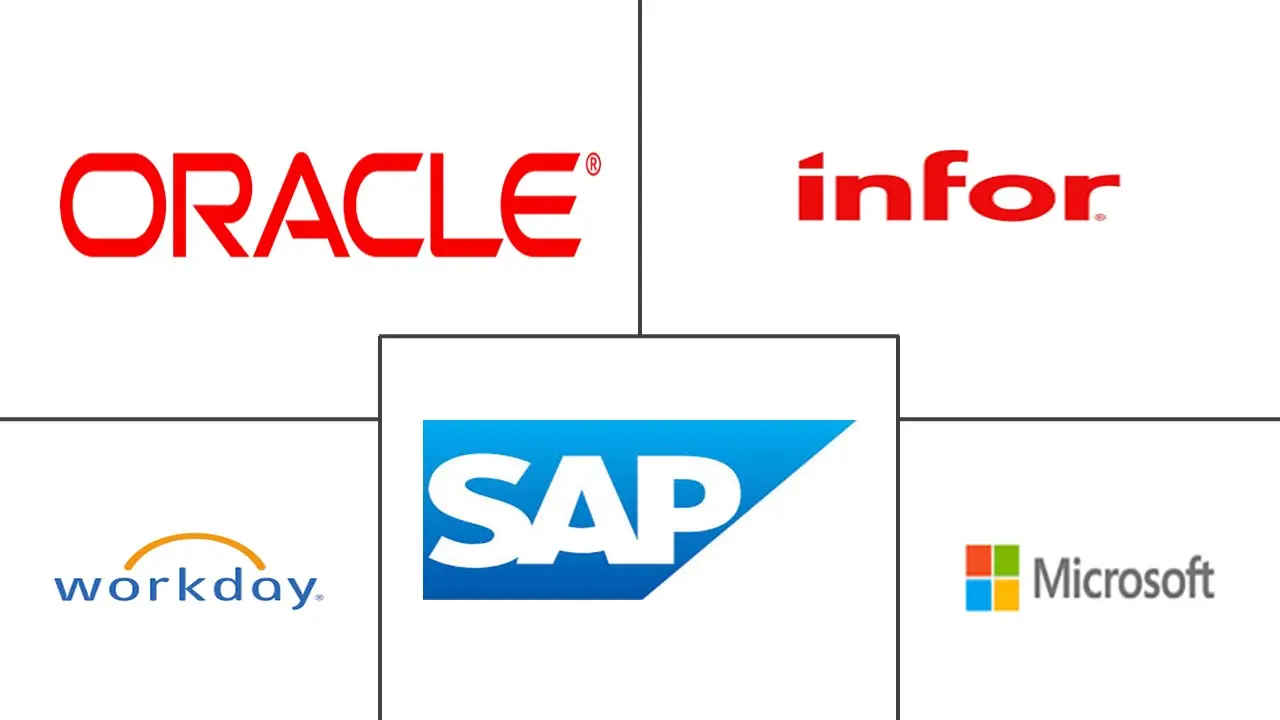
Enterprise Resource Planning Market Analysis by Mordor Intelligence
The Enterprise Resource Planning Market size is estimated at USD 71.62 billion in 2025, and is expected to reach USD 114.09 billion by 2030, at a CAGR of 9.76% during the forecast period (2025-2030).
Strong demand for integrated process automation, faster cloud migration, and AI-enabled analytics is propelling expansion across manufacturing, services, and public-sector organizations. Vendors have shifted road maps toward cloud-native suites that lower infrastructure costs, while enterprises accelerate modernization to improve real-time visibility and regulatory compliance. Spurred by mandatory e-invoicing laws and ESG accounting requirements, companies are prioritizing embedded compliance capabilities that reduce audit risk and support cross-border operations. Competitive dynamics are shaped by a shortfall of skilled consultants, prompting providers to invest in low-code configuration tools that shorten deployment timelines and lower total cost of ownership.
Key Report Takeaways
- By offering, solutions captured 58.91% of the enterprise resource planning market share in 2024, while services are projected to expand at 13.89% CAGR through 2030.
- By deployment, cloud models held a 55.73% share of the enterprise resource planning market size in 2024, while hybrid models are projected to expand at a 16% CAGR through 2030.
- By enterprise size, large companies commanded a 37.16% share of the enterprise resource planning market size in 2024, while SMEs are projected to expand at a 14.91% CAGR through 2030.
- By end-user industry, manufacturing accounted for 24.89% of the enterprise resource planning market share in 2024, while IT and telecom are projected to expand at 16.34% CAGR through 2030.
- By geography, North America led with a 34.31% revenue share in 2024, while the Asia-Pacific region is set to climb at a 12.15% CAGR through 2030.
Global Enterprise Resource Planning Market Trends and Insights
Driver Impact Analysis
| Driver | (~) % Impact on CAGR Forecast | Geographic Relevance | Impact Timeline |
|---|---|---|---|
| Cloud-first migration momentum | +2.8% | North America, Europe | Medium term (2-4 years) |
| AI-driven analytics embedded in ERP | +2.1% | Global developed markets | Long term (≥ 4 years) |
| SME SaaS adoption surge | +1.9% | Asia-Pacific, Latin America, MEA | Short term (≤ 2 years) |
| Mandatory e-invoicing mandates | +1.4% | Europe, Latin America, Asia-Pacific | Medium term (2-4 years) |
| ESG accounting add-ons for Scope-3 tracking | +0.8% | North America, EU, Asia-Pacific | Long term (≥ 4 years) |
| Generative AI user experiences | +0.6% | Global tier-one markets | Long term (≥ 4 years) |
| Source: Mordor Intelligence | |||
Cloud-First Migration Momentum
Organizations are accelerating the shift from on-premise suites to cloud-based enterprise resource planning market deployments to gain scalability, flexible pricing, and lower maintenance overhead. IFS reported a 38% year-over-year rise in cloud recurring revenue for 2024 that lifted annual recurring revenue above EUR 1 billion (USD 1.16 billion).[1]Björn Rosengren, “IFS Announces Outstanding 2024 Financial Results Driven by Industrial AI Demand,” IFS, ifs.com Mid-market firms are especially drawn to subscription models that convert capital expense to operating expense, while large enterprises use vendor migration programs such as RISE with SAP to consolidate fragmented landscapes. Cloud delivery also lets providers release continuous functional updates, keeping customers current on tax rules and security patches without costly version upgrades.
AI-Driven Analytics Embedded in ERP
Artificial intelligence is transforming the enterprise resource planning market from a record-keeping backbone into an intelligent decision platform. Acumatica’s AI-first strategy, unveiled at its 2025 summit, embeds machine learning that predicts late payments, optimizes production runs, and recommends purchase quantities.[2]Acumatica Shares Upcoming Innovations, Unveils AI-First Product Strategy,” Acumatica, acumatica.com Similar capabilities in NetSuite 2024 releases let employees generate reports through plain-language prompts, expanding advanced analytics to nontechnical users. Internal benchmark studies from leading vendors show that AI-enabled forecasting can cut working-capital buffers by as much as 30%, freeing cash for growth initiatives.
SME SaaS Adoption Surge
Falling subscription prices and industry-specific templates are drawing small and medium enterprises into the enterprise resource planning market at double-digit rates. Vendors now offer implementation accelerators that reduce deployment cycles to weeks, replacing traditional 12-month projects. In the Asia-Pacific region, government digitalization grants and mobile-first workforces amplify demand for cloud suites that operate reliably on low-cost devices. Providers respond with localized tax packs and multilingual support, removing historical barriers linked to upgrade cost and language complexity.
Regulatory-Driven Adoption of Native E-Invoicing in ERP Systems
Regulators in Germany, Croatia, Malaysia, and 12 more countries enforced e-invoicing requirements in 2024 that demand real-time invoice submission to tax authorities. ERP vendors have launched certified e-invoicing connectors that automate data exchange and mapping, erasing manual rekeying errors and audit risk. Organizations unable to comply face fines or payment delays, making native e-invoicing a trigger for new enterprise resource planning market purchases.
Restraint Impact Analysis
| Restraint | (~) % Impact on CAGR Forecast | Geographic Relevance | Impact Timeline |
|---|---|---|---|
| High implementation and switching costs | -1.8% | Global emerging markets | Short term (≤ 2 years) |
| Data integration and legacy complexity | -1.2% | North America, Europe | Medium term (2-4 years) |
| Rising data-sovereignty laws | -0.9% | Global | Long term (≥ 4 years) |
| Shortage of micro-vertical ERP talent | -0.7% | Global developed markets | Medium term (2-4 years) |
| Source: Mordor Intelligence | |||
High Implementation and Switching Costs
Initial license fees, process redesign, and staff training can push enterprise resource planning market projects into the USD 1 million range for mid-size companies. Panorama Consulting surveys show that total project cost often doubles after factoring in data migration and change management, extending payback periods.[3]Eric Kimberling, “Panorama Releases Latest Study of ERP Implementation Outcomes,” Panorama Consulting Group, panorama-consulting.com Budget pressure is most acute among resource-constrained firms, although SaaS plans now spread expenditure over multi-year terms to ease upfront cash outflow.
Shortage of Micro-Vertical ERP Talent
Global demand for certified consultants exceeds supply, with industry sources estimating a 30,000-40,000 person shortfall for SAP alone. Scarcity prolongs implementation cycles and elevates daily rates, especially in regulated sectors such as healthcare, aerospace, and utilities. Vendors are addressing the talent shortage by introducing automated configuration wizards and industry-specific starter packs. However, the persistent talent gap continues to hinder the growth of the enterprise resource planning market.
Segment Analysis
By Offering: Services Accelerate Despite Solutions Dominance
Solutions retained a 58.91% share of the enterprise resource planning market in 2024 as core financial, supply-chain, and HR modules remain essential for digital operations. Services, however, are climbing at 13.89% CAGR, reflecting the growing complexity of AI configuration, cloud migration, and regulatory tailoring. The enterprise resource planning market size attributed to services is projected to nearly double by 2030 as organizations prioritize process redesign and continuous improvement over feature parity.
Enterprises now demand industry-specific consulting, data-cleansing, and user-adoption training more than additional software modules. Providers such as Acumatica have introduced professional-services editions that bundle project accounting, resource scheduling, and revenue recognition functionality to accelerate deployment in consulting, legal, and creative agencies. As commoditization lowers software margins, leading vendors expect services revenue to offset declining license fees.

By Deployment: Hybrid Models Challenge Cloud Supremacy
Cloud architectures commanded 55.73% share of the enterprise resource planning market in 2024, a clear preference for new implementations. Yet hybrid patterns—mixing private cloud, public cloud, and on-premise components—are expanding at a 16% CAGR. Multinational groups often retain finance ledgers onsite for data-sovereignty reasons while running analytics and collaboration workloads in regional clouds. The enterprise resource planning market size for hybrid solutions is forecast to outpace pure cloud deployments between 2025-2030 as security-sensitive sectors balance control with elasticity.
SAP’s RISE program illustrates hybrid momentum by allowing customers to host S/4HANA instances on hyperscale clouds while integrating with on-premise manufacturing execution systems. This flexible posture lowers latency for shop-floor transactions yet preserves global report consolidation in the cloud, a model gaining favor among pharmaceutical and automotive producers.
By Enterprise Size: SMEs Drive Market Democratization
Large organizations held a 37.16% share of the enterprise resource planning market size in 2024, as their multi-entity structures necessitated comprehensive suites with advanced governance. Nevertheless, SMEs represent the most energetic adopter cohort at 14.91% CAGR. Rapid start programs priced per-user-per-month let startups deploy quoting, invoicing, and inventory workflows without capital expenditure, reinforcing the democratization of the enterprise resource planning market access.
Low-code customization tools now let non-technical staff extend forms, add dashboards, and connect e-commerce storefronts. This self-service ethos reduces reliance on external agencies, a pressing concern for small firms with constrained budgets. Vendors gain recurring revenue while customers achieve enterprise-grade control over cash and inventory earlier in their growth journey.

By End-User Industry: Manufacturing Leadership Faces IT Sector Challenge
Manufacturing contributed the largest 24.89% share of the enterprise resource planning market in 2024, thanks to intricate bill-of-materials tracking, production scheduling, and supplier collaboration needs. The sector is modernizing through Industry 4.0 initiatives that integrate IoT sensors for predictive maintenance and automated quality checks. The enterprise resource planning market share of manufacturing is expected to remain dominant through 2030, although its growth rate lags the dynamic IT and telecom segment.
IT and telecom revenues are climbing at 16.34% CAGR as subscription billing, customer lifecycle analytics, and stringent data-security rules outpace legacy solutions. Telecom operators increasingly embed monetization engines and regulatory reporting inside unified ERP cores to accommodate 5G usage-based pricing. This real-time orientation favors cloud-native platforms able to process high-volume transactions with sub-second latency.
Geography Analysis
North America accounted for 34.31% of the enterprise resource planning market revenue in 2024, anchored by high cloud adoption, robust partner networks, and a concentration of Fortune 500 organizations. Early SaaS pioneers and a mature venture-capital ecosystem sustain demand for modern suites that integrate AI and advanced analytics. Digital-first government procurement policies further stimulate uptake among public-sector agencies.
Europe preserves steady growth with mainstream penetration in manufacturing and public administration, yet mandatory e-invoicing laws are prompting a new replacement cycle. Vendors answer with localized tax engines, GDPR-compliant data-residency options, and pre-configured charts of accounts. These capabilities underpin stable mid-single-digit growth as firms refresh aging on-premise platforms in favor of subscription models.
Asia-Pacific is the fastest-growing territory at a 12.15% CAGR, driven by industrial expansion in China, India, and Southeast Asia. Government grants, affordable mobile broadband, and rising cloud infrastructure availability propel cloud ERP deployments among mid-tier manufacturers and service firms. Hyperscale providers are building regional data centers that satisfy data-sovereignty clauses and accelerate user response times, ensuring the enterprise resource planning market maintains double-digit momentum across the region.

Competitive Landscape
The enterprise resource planning market demonstrates moderate consolidation. SAP, Oracle, and Microsoft anchor global share positions through broad functional coverage and expansive partner ecosystems. SAP surpassed 24,000 RISE cloud customers in 2025, while Oracle Fusion Cloud added predictive planning and ESG accounting modules that deepen vertical specialization.
Challenger vendors such as IFS and Acumatica exploit focused sector expertise. IFS exceeded EUR 1 billion recurring revenue in 2024 by emphasizing industrial asset management with built-in AI that predicts machine failure. Acumatica pursues mid-market manufacturers and distributors with unlimited-user licensing and open APIs, registering compound annual revenue growth above 25% since 2021.
Specialist providers target micro-vertical gaps. Unit4 focuses on professional-services organizations needing complex project accounting, while Plex extends native manufacturing execution for food and beverage processors. This fragmentation below the top tier keeps competitive pressure high and accelerates the pace of innovation across financials, supply chain, and workforce management.
Enterprise Resource Planning Industry Leaders
-
Microsoft Corporation
-
SAP SE
-
Microsoft Corporation
-
Workday, Inc.
-
Infor Inc.
- *Disclaimer: Major Players sorted in no particular order

Recent Industry Developments
- May 2025: Acumatica unveiled its AI-first product strategy at Summit 2025, integrating machine learning across manufacturing, distribution, and finance modules.
- March 2025: iFabric Corp invested CAD 500,000 (USD 370,000) in BlueCherry ERP to streamline operations and support growth goals.
- February 2025: : IFS partnered with Saudi Business Machines to deliver integrated IT solutions in Saudi Arabia, broadening Middle East reach.
- January 2025: IFS reported annual recurring revenue topping EUR 1 billion (USD 1.05 billion) on 32% growth, adding more than 350 new customers.
- January 2025: Proteus Technologies launched Vision AI inside Vision ERP, adding predictive analytics and automated workflows for manufacturing and retail clients.
Global Enterprise Resource Planning Market Report Scope
Software programs that integrate multiple company processes and operations into a unified platform are called enterprise resource planning or ERP. These processes include manufacturing, supply chain management, finance, and human resources.
The enterprise resource planning (ERP) market is segmented by offering (solutions and services), function (HR, supply chain, finance, marketing, and other functions), deployment (on-premise and hybrid), organization size (small and medium enterprises and large enterprises), industry verticals (BFSI, IT and telecom, government, retail and e-commerce, manufacturing, oil, gas, and energy, and other industry verticals), and geography (North America, Europe, Asia-Pacific, Latin America, and Middle East and Africa). The report offers the market size and forecasts for all the above segments in value (USD).
| Solutions |
| Services |
| On-premise |
| Cloud |
| Hybrid |
| Human Resources |
| Supply Chain |
| Finance |
| Marketing |
| Other Function |
| Large Enterprises |
| Small and Medium-Sized Enterprises |
| Manufacturing |
| Retail and E-commerce |
| BFSI |
| IT and Telecom |
| Government and Public Sector |
| Energy and Utilities |
| Healthcare |
| Other End-user Industry |
| North America | United States | |
| Canada | ||
| Mexico | ||
| Europe | Germany | |
| United Kingdom | ||
| France | ||
| Russia | ||
| Rest of Europe | ||
| Asia-Pacific | China | |
| Japan | ||
| India | ||
| South Korea | ||
| Australia | ||
| Rest of Asia-Pacific | ||
| Middle East and Africa | Middle East | Saudi Arabia |
| United Arab Emirates | ||
| Rest of Middle East | ||
| Africa | South Africa | |
| Egypt | ||
| Rest of Africa | ||
| South America | Brazil | |
| Argentina | ||
| Rest of South America | ||
| By Offering | Solutions | ||
| Services | |||
| By Deployment | On-premise | ||
| Cloud | |||
| Hybrid | |||
| By Function | Human Resources | ||
| Supply Chain | |||
| Finance | |||
| Marketing | |||
| Other Function | |||
| By Enterprise Size | Large Enterprises | ||
| Small and Medium-Sized Enterprises | |||
| By End-user Industry | Manufacturing | ||
| Retail and E-commerce | |||
| BFSI | |||
| IT and Telecom | |||
| Government and Public Sector | |||
| Energy and Utilities | |||
| Healthcare | |||
| Other End-user Industry | |||
| By Geography | North America | United States | |
| Canada | |||
| Mexico | |||
| Europe | Germany | ||
| United Kingdom | |||
| France | |||
| Russia | |||
| Rest of Europe | |||
| Asia-Pacific | China | ||
| Japan | |||
| India | |||
| South Korea | |||
| Australia | |||
| Rest of Asia-Pacific | |||
| Middle East and Africa | Middle East | Saudi Arabia | |
| United Arab Emirates | |||
| Rest of Middle East | |||
| Africa | South Africa | ||
| Egypt | |||
| Rest of Africa | |||
| South America | Brazil | ||
| Argentina | |||
| Rest of South America | |||
Key Questions Answered in the Report
How fast is cloud deployment growing inside enterprise resource planning suites?
Cloud models are expanding at a 16% CAGR through 2030 as organizations pursue scalable infrastructure and subscription pricing.
Which segment is the largest revenue contributor to ERP today?
Core software solutions delivered 58.91% of 2024 revenue, reflecting their role as the foundational platform for integrated business processes.
Why are SMEs accelerating ERP adoption?
Low-cost SaaS subscriptions and pre-configured industry templates have cut implementation timelines to weeks, removing historical capital barriers.
What role does AI play in modern ERP systems?
Embedded AI automates routine workflows, generates predictive insights, and allows natural language querying, which cuts operational costs and improves decision accuracy.
Which region is the fastest-growing ERP market through 2030?
Asia-Pacific is set to rise at a 12.15% CAGR due to industrial expansion, government digitalization programs, and widespread mobile connectivity.
Page last updated on:



